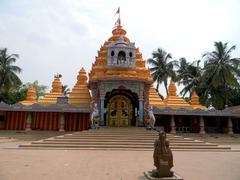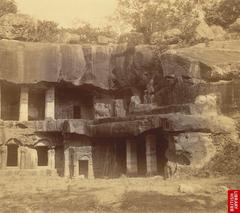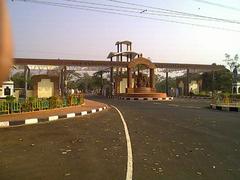Brahmeswara Temple Visiting Hours, Tickets, and Bhubaneswar Historical Sites Guide
Date: 14/06/2025
Introduction
Brahmeswara Temple, located in the heart of Bhubaneswar—often known as the “Temple City of India”—is a masterwork of early Kalinga temple architecture and a vibrant spiritual hub. Built in 1058 CE under the Somavamsi dynasty, this ancient shrine is dedicated to Lord Shiva and is renowned for its panchayatana layout, exquisite sandstone carvings, and integration of performing arts into temple life (Culture and Heritage, Indianetzone).
This guide provides in-depth information on Brahmeswara Temple’s historical context, architectural features, visiting hours, ticketing, accessibility, nearby attractions, and practical travel tips to help you make the most of your visit to Bhubaneswar’s remarkable heritage sites.
Historical Background and Significance
Origins and Patronage
Commissioned in 1058 CE by Queen Kolavati Devi, mother of King Udyotakesari of the Somavamsi dynasty, Brahmeswara Temple is a pivotal example of Odisha’s temple-building tradition. The Somavamsi period marked an era of architectural innovation, with Brahmeswara Temple reflecting both religious devotion and artistic sophistication (Optima Travels).
Architectural Highlights
The temple features a panchayatana layout—a central sanctum (vimana or deul) with four subsidiary shrines at each corner of the complex. Rising nearly 60 feet, the temple is constructed from finely carved sandstone and capped by a curvilinear shikhara. Its elaborate exterior and interior sculptures depict deities, musicians, dancers, and tantric motifs, underscoring the temple’s significance as a center for ritual, art, and culture.
Artistic and Cultural Legacy
Brahmeswara Temple is notable as one of India’s earliest temples to systematically integrate representations of musicians and dancers into its sculptural program. This innovation reflects the close bond between spirituality and the performing arts in 11th-century Odisha, laying the groundwork for the development of Odissi dance and music traditions (Culture and Heritage).
Religious and Cultural Context
Dedication and Rituals
Dedicated to Lord Shiva, Brahmeswara Temple is an active place of worship, hosting daily rituals and major festivals, with Maha Shivaratri being the most prominent. During festivals, the temple draws large numbers of devotees and features special ceremonies and cultural performances, making it a focal point of Bhubaneswar’s spiritual life (Optima Travels).
Devadasi Tradition and Performing Arts
Historical records and inscriptions reveal that Queen Kolavati Devi institutionalized the Devadasi tradition at Brahmeswara, introducing temple dancers as an integral part of religious ceremonies. This tradition significantly influenced the evolution of Odissi dance and temple music, with the temple’s sculptures documenting the cultural milieu of its time (Culture and Heritage).
Architectural Features and Iconography
Layout and Structure
The temple complex consists of a main sanctum (vimana) and a frontal hall (jagamohana or mandapa), both aligned east-west. The structure is built from ochre sandstone, and the outer compound includes four subsidiary shrines, forming a classic panchayatana arrangement (Indianetzone).
Sculptures and Symbolism
- Torana (Gateway): The intricately carved Torana is a rare and celebrated feature, adorned with mythological figures, floral motifs, and scenes from Hindu epics (cultureandheritage.org).
- Exterior Walls: Richly decorated with deities, mythical creatures, musicians, dancers, and narrative panels from the Ramayana and Mahabharata.
- Dikpalas: Eight guardian deities carved on the temple walls symbolize the cosmic order.
- Erotic and Tantric Imagery: Sculptures representing fertility and esoteric aspects of Hindu theology.
The sanctum houses a large Shiva lingam, while the surrounding carvings and meditative motifs are designed to inspire contemplation.
Visiting Brahmeswara Temple: Hours, Tickets, and Practical Information
Visiting Hours
- Open daily: 6:00 AM to 8:00 PM (Trawell.in)
Ticket Information
- Entry: Free for Indian citizens; foreign visitors may be asked to pay a nominal fee of ₹50 (~$0.70 USD) (Trawell.in)
- Donations: Voluntary contributions are appreciated to support temple maintenance.
How to Reach
- Location: Tankapani Road, Bhubaneswar, Odisha.
- Transport: Easily accessible by taxi, auto-rickshaw, or city bus.
- Nearest railway station: Bhubaneswar Railway Station (approx. 5 km).
- Nearest airport: Biju Patnaik International Airport (approx. 7 km) (Capture A Trip).
Accessibility
- Wheelchair access: Ramps are available at the entrance and in the courtyard, though the main shrine has steps.
- Facilities: Basic amenities; no restrooms within the temple, but available nearby.
Guided Tours
- Availability: Local guides and heritage tours are offered by city operators and Odisha Tourism. Booking a guide is recommended for historical context and in-depth experience.
Photography
- Allowed: Photography is permitted in the complex, but refrain from using flash inside the sanctum and always respect ongoing rituals (Velpu).
Best Time to Visit and Festival Highlights
Seasonal Tips
- October to February: Pleasant weather and ideal for sightseeing (Capture A Trip).
- March to May: Hot and humid; visit early morning or late evening.
- June to September: Monsoon season; lush surroundings but heavy rain possible.
Festival Experience
- Maha Shivaratri: The temple comes alive with rituals, music, and dance.
- Other festivals: Ratha Yatra and local celebrations add to the cultural vibrancy (Capture A Trip).
Dress Code, Etiquette, and Visitor Tips
- Dress modestly (shoulders and knees covered).
- Remove shoes before entering the temple.
- Maintain silence and respect ongoing rituals.
- Avoid touching idols and bringing food or drinks inside the temple.
- Carry water, especially during warmer months.
- Plan your transport in advance, especially for early or late visits.
Nearby Attractions and Itinerary Suggestions
- Lingaraj Temple: 3 km away; a major Shiva temple.
- Mukteswara Temple: Renowned for its ornate carvings.
- Rajarani Temple: Noteworthy for unique architecture.
- Udayagiri and Khandagiri Caves: Rock-cut caves 8 km from Brahmeswara.
- Odisha State Museum: For insights into regional culture and history.
A full day can be spent exploring Brahmeswara Temple in combination with these nearby sites (Trawell.in, Capture A Trip).
Safety and Accessibility
- The temple is generally safe for visitors, with regular foot traffic.
- Keep personal belongings secure, especially during festivals.
- Wheelchair access is limited to the outer areas.
- English is commonly understood at tourist spots, though signage may be minimal.
Frequently Asked Questions (FAQs)
Q: What are the Brahmeswara Temple visiting hours?
A: The temple is open daily from 6:00 AM to 8:00 PM.
Q: Is there an entry fee for Brahmeswara Temple?
A: Entry is free for Indian visitors; foreign tourists may pay a nominal fee.
Q: Are guided tours available?
A: Yes, local guides and heritage tours can be arranged.
Q: Is photography allowed?
A: Yes, generally throughout the complex, but avoid flash in the sanctum.
Q: Is Brahmeswara Temple accessible to people with disabilities?
A: Wheelchair access is available in the courtyard, but there are steps to the main shrine.
Q: What is the best time to visit?
A: October to February is ideal for pleasant weather and festival experiences.
Visual Highlights
Include high-quality images with descriptive alt text, such as:
- “Brahmeswara Temple exterior view - Bhubaneswar historical site”
- “Intricate stone carvings at Brahmeswara Temple, Bhubaneswar”
- “Brahmeswara Temple Torana entrance”
- “Lotus motifs on jagamohana ceiling”
Summary
Brahmeswara Temple is an essential destination in Bhubaneswar for its blend of spiritual energy, architectural beauty, and cultural significance. Its 11th-century origins, distinctive panchayatana layout, and pioneering celebration of performing arts in sculpture make it a jewel of Odisha’s heritage (Culture and Heritage, Indianetzone, Optima Travels, TripXL).
Plan your visit between October and March for the best experience, consider engaging a local guide, and respect temple customs to enrich your exploration. For deeper insight and planning resources, consult the references below.
References and Further Reading
- Brahmeswara Temple - Wikipedia
- Culture and Heritage: Brahmeswara Temple
- Optima Travels: Brahmeswara Temple
- Indianetzone: Brahmeswara Temple
- Trawell.in: Brahmeswara Temple
- Capture A Trip: Best Time to Visit Bhubaneswar
- TripXL: Brahmeswara Temple
For more travel tips, heritage itineraries, and virtual tours, download the Audiala app and follow our blog for the latest updates on Bhubaneswar historical sites.








